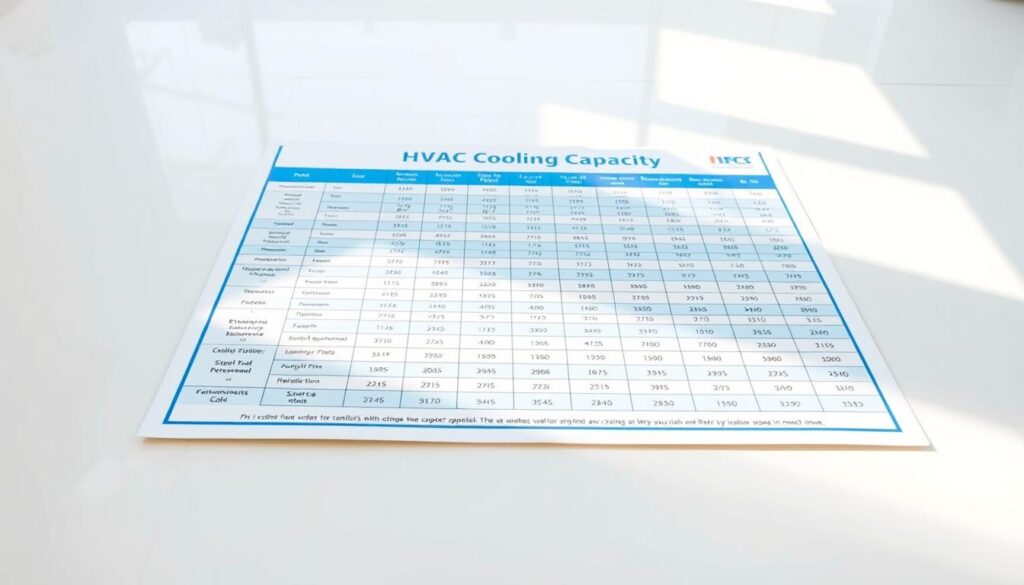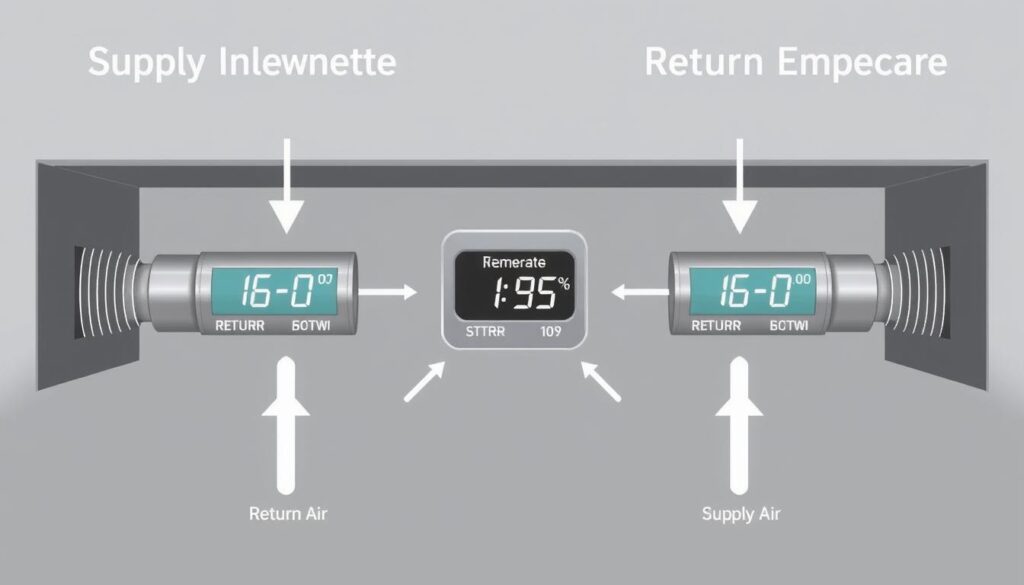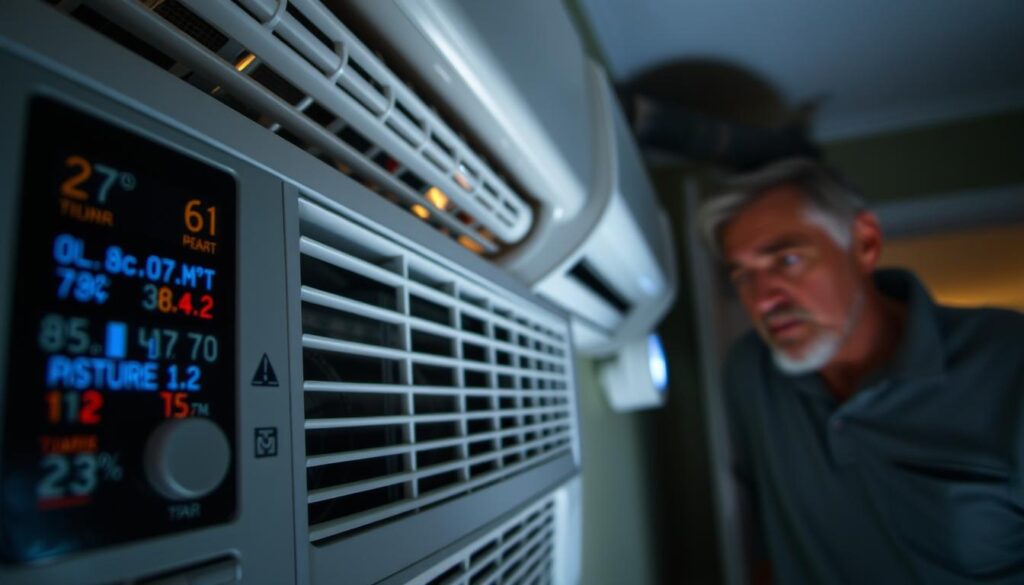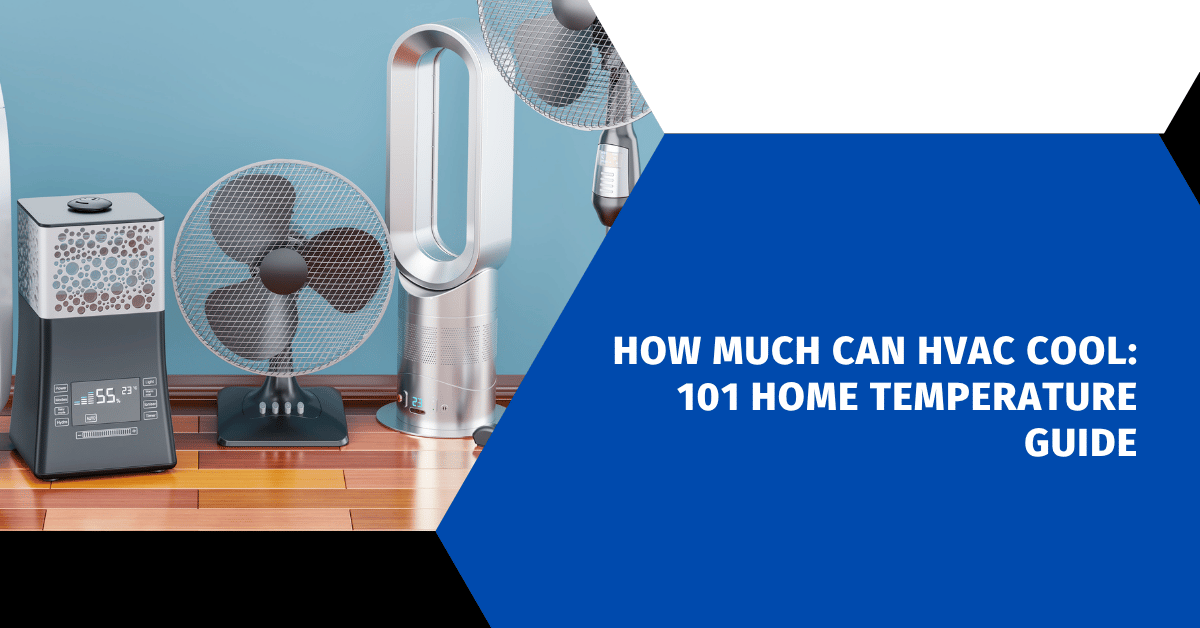Affiliate Disclosure
HVAC Guide Guys is a participant in the Amazon Services LLC Associates Program, an affiliate advertising program designed to provide a means for sites to earn advertising fees by advertising and linking to Amazon.
How Much Can HVAC Cool? Ever thought about how much your HVAC can cool your home before it gets too hot? Knowing your HVAC’s cooling power is key to staying comfy and saving energy at home.

The U.S. Department of Energy suggests keeping your home at 78 degrees in summer. But, every HVAC system cools differently. How much your system can cool depends on several factors that affect its performance and comfort.
This guide will dive into HVAC cooling capacity, explaining how your system works, its limits, and ways to get the most out of it. If you’re dealing with hot spots or high energy costs, knowing more can help a lot.
Key Takeaways
- HVAC cooling capacity varies by system size and design
- Proper maintenance impacts overall cooling efficiency
- Temperature settings directly influence energy consumption
- Understanding BTU ratings helps optimize home comfort
- Regular system checks prevent performance degradation
Table of Contents
Understanding HVAC Cooling Capacity Basics
Keeping your home cool is key, and knowing your HVAC system’s cooling power is essential. The right size HVAC system can greatly affect your home’s comfort and energy use.
HVAC cooling power is measured in British Thermal Units (BTU). This shows how well your system can cool a certain area. The BTU rating helps you pick the right system for your home.
Key Components of HVAC Cooling Capacity
- BTU ratings show cooling power
- System size affects performance
- Home size determines needed capacity
Factors Influencing Cooling Performance
Several important factors impact your HVAC system’s cooling ability:
- Insulation quality
- Ceiling height
- Sun exposure
- Number of people living there
Getting an accurate HVAC load calculation is key for efficient cooling. Experts use special formulas to find the best system for your home.
“The right HVAC system can cut energy costs by up to 30%” – Energy Star
| Home Size (sq ft) | Recommended BTU | Cooling Capacity |
|---|---|---|
| 500-700 | 10,000 | Good for small apartments |
| 700-1000 | 14,000 | Suitable for medium rooms |
| 1000-1500 | 18,000 | Ideal for larger spaces |
Choosing the right HVAC system is about finding the right balance. It’s about cooling power and energy efficiency.
How Much Can HVAC Cool: Real Temperature Limits
Knowing your HVAC cooling power’s real limits is key to staying cool at home during hot summer days. Your air conditioning system has certain abilities that affect how well it cools your space.
An HVAC system can lower indoor temperatures by 15-25 degrees from outside. This range depends on several important factors:
- Outdoor ambient temperature
- System efficiency
- Home insulation quality
- Age of the HVAC equipment
When it’s over 90°F outside, your air conditioning might find it hard to keep your home cool. The bigger the temperature difference, the more your system has to work. Most home HVAC systems aim for a 20-degree difference between inside and outside.
To get the most out of your cooling, try these tips:
- Keep your system well-maintained
- Improve your home’s insulation
- Use ceiling fans to improve air flow
- Close blinds when it’s sunny
Homeowners should have realistic expectations about their cooling system’s performance. Even with modern HVAC tech, knowing your system’s limits helps you prepare for extreme heat.
Explore Our HVAC Shop
Looking for top-rated HVAC tools, parts, and accessories? Visit our shop and find the perfect solution for your needs.
Visit the ShopOptimal Temperature Settings for Energy Efficiency
Smart temperature management is key to better hvac energy efficiency. Your home’s comfort and energy use depend on your thermostat settings. These settings change based on the time of day and situation.
Knowing your hvac climate zone is important for setting the right temperatures. Different areas have different temperature ranges. This affects how your HVAC system works.
Daytime Temperature Recommendations
Experts say to keep indoor temperatures between 75-78°F during the day. This balance of comfort and energy savings is best:
- Set thermostat between 75-78°F when home
- Use ceiling fans to enhance cooling perception
- Minimize heat-generating activities during peak temperatures
Nighttime Temperature Settings
Nighttime is a chance to cut down on energy use. Try these tips:
- Lower thermostat by 7-10°F while sleeping
- Utilize programmable thermostats for automatic adjustments
- Wear light, breathable sleepwear for comfort
Away-from-Home Settings
When you’re away, smart temperature settings can save a lot on energy costs:
- Raise thermostat 7-10°F during summer
- Invest in smart home technology for remote adjustments
- Protect home from direct sunlight using blinds or curtains
“Every degree of adjustment can save approximately 3% on your cooling costs.” – Energy Efficiency Experts
Understanding Supply and Return Air Temperature

Your HVAC system keeps your home comfortable by moving air around. The cooling power of your HVAC depends on how well air moves between supply and return vents. Return vents are key, pulling warm air from rooms into the system.
Warm air enters through return vents. Inside, it cools down as it passes over cooling coils. These coils use refrigerant to take heat away, making the air cool and comfortable.
- Return vents collect warm air from living spaces
- Cooling coils reduce air temperature
- Refrigerant absorbs heat during the process
- Cooled air is redistributed through supply ducts
Good duct design is important for your system’s performance. Balanced airflow ensures consistent cooling and maintains optimal temperature distribution. Bad ductwork can make your HVAC less effective by blocking air flow and causing uneven temperatures.
| Air Type | Temperature Range | Key Function |
|---|---|---|
| Return Air | 70-80°F | Collect warm indoor air |
| Supply Air | 55-65°F | Distribute cooled air |
Knowing how supply and return air work together helps you understand your HVAC system better. It shows how to keep your system running well and keeping you comfortable.
Explore Our HVAC Shop
Looking for top-rated HVAC tools, parts, and accessories? Visit our shop and find the perfect solution for your needs.
Visit the ShopCalculating Your HVAC System’s Delta T
To understand your HVAC cooling power, you need to measure the temperature difference, or Delta T. This important step helps you figure out your home’s cooling needs and how well it works.
Delta T shows the temperature gap between the air going into and out of your cooling system. Experts say keeping this gap between 16 to 22°F is best for good performance.
Steps to Measure Temperature Difference
To find your HVAC system’s Delta T, just follow these easy steps:
- Find the return air vent
- Use a digital thermometer to measure the return air temperature
- Locate the supply air vent
- Measure the supply air temperature
- Subtract the supply air temperature from the return air temperature
Interpreting Delta T Results
Your Delta T reading gives you important info about your cooling system. If it’s not between 16-22°F, it might mean:
- Refrigerant problems
- Blocked airflow
- A system malfunction
When to Call a Professional
If your Delta T is always too low (less than 15°F) or too high (more than 24°F), call an HVAC expert. They can do a detailed cooling load calculation and find any system issues.
Getting accurate Delta T readings is key to improving your home’s cooling efficiency.
Common Factors Limiting HVAC Performance
Your HVAC system’s cooling power can be affected by several key factors. Knowing these can help keep your home comfortable and save energy.
How well your HVAC is installed is very important. A bad installation can cut cooling power by up to 30%. This makes your home too hot and raises your energy bills.
- Undersized Units: A small HVAC system can’t cool your whole home
- Refrigerant Leaks: They lower cooling power and system efficiency
- Dirty Air Filters: They block airflow and reduce cooling
Your home’s design affects how well your HVAC cools it. Poor insulation, old windows, and too much sun can be too much for any cooling system.
Keeping your HVAC in good shape and making smart home changes can really boost its cooling power.
Some big problems include:
- Bad ductwork design
- Blocked air vents
- Old equipment
- Too much heat outside
Getting regular checks from pros can spot and fix these issues. This ensures your HVAC works its best.
Explore Our HVAC Shop
Looking for top-rated HVAC tools, parts, and accessories? Visit our shop and find the perfect solution for your needs.
Visit the ShopMaximizing Your HVAC System’s Cooling Power
To keep your HVAC system at its best, you need to maintain it well and use smart cooling methods. Your system’s cooling power depends on regular care and smart energy use.
Keeping your HVAC system efficient is key. By using the right strategies, you can make your system cool better and use less energy.
Maintenance Tips for Optimal Cooling
- Replace air filters every 90 days
- Schedule professional HVAC inspections annually
- Clean air vents and registers monthly
- Check refrigerant levels regularly
Improving Airflow Efficiency
Airflow is important for your HVAC system’s cooling. Making sure air flows freely can greatly improve cooling power.
| Airflow Enhancement Strategy | Potential Efficiency Improvement |
|---|---|
| Clear furniture from vents | Up to 15% improved airflow |
| Seal ductwork leaks | 20-30% energy savings |
| Use ceiling fans | 4-5 degrees perceived cooling |
Reducing Heat Load
Less heat in your home means your HVAC system works better. Here are ways to improve energy efficiency:
- Install thermal curtains
- Use reflective roof coatings
- Add insulation to attic spaces
- Plant shade trees near windows
By being proactive and using smart cooling methods, you can make your HVAC system work better. This means more comfort with less energy use.
Signs Your HVAC System Is Struggling to Cool

Knowing when your HVAC system is not cooling well can save you money and keep your home comfortable. If your air conditioner is not cooling as it should, you might see some warning signs. These signs show that your HVAC system’s cooling power is not what it used to be.
Look out for these important signs that your cooling system is under stress:
- Uneven Cooling: Some rooms feel much warmer than others, showing poor air flow
- Constant Running: Your system runs all the time without cooling your space enough
- Extended Cooling Cycles: The AC takes longer than usual to cool your space
- Unexplained High Energy Bills: Your electricity bills go up without better cooling
Temperature differences are key to understanding your HVAC’s performance. If your air conditioner can’t keep a steady temperature within 15-25 degrees of what you set, it might not be working well.
Possible reasons for cooling problems include:
- Blocked air filters that limit airflow
- Refrigerant leaks that lower cooling efficiency
- Old or the wrong size equipment
- Not enough insulation in your home
Fixing these problems quickly can stop bigger issues and bring back your home’s comfort.
Energy-Saving Cooling Strategies
Lowering your home’s cooling costs is easy. Smart HVAC energy strategies can save you money and keep your home comfy. Knowing your hvac climate zone is key to a good cooling plan.
The Department of Energy says raising your thermostat by one degree can cut utility bills by 3 percent. This small change can save a lot of money each year.
- Install a programmable thermostat to automate temperature control
- Use zoning systems to cool specific areas more efficiently
- Implement smart home technologies for advanced temperature management
- Leverage passive cooling techniques to reduce HVAC workload
Passive cooling can make your home much more energy-efficient. Here are some tips:
- Use light-colored window treatments to reflect sunlight
- Seal air leaks around windows and doors
- Plant shade trees near your home’s sunny areas
- Use ceiling fans to enhance air circulation
Your hvac climate zone affects your cooling strategy. Different areas need different plans to keep temperatures right. Talking to a local HVAC expert can help you create a plan that fits your area.
Small changes in your cooling habits can lead to substantial energy savings and improved home comfort.
Explore Our HVAC Shop
Looking for top-rated HVAC tools, parts, and accessories? Visit our shop and find the perfect solution for your needs.
Visit the ShopWhen to Consider HVAC System Upgrades
Upgrading your HVAC system can save money and make your home more comfortable. Old systems often can’t keep temperatures right, leading to higher energy bills and less cooling.
The size of your HVAC system is key in deciding when to upgrade. Systems over 15 years old should be checked carefully for replacement.
Modern Cooling Technologies
New HVAC technologies bring big benefits to homeowners:
- Inverter-driven compressors with variable speed capabilities
- Smart thermostats with advanced temperature control
- Improved energy efficiency ratings
- Zoned cooling systems for personalized comfort
Cost-Benefit Analysis Framework
When looking at HVAC installation needs, consider these important points:
- Current system’s energy efficiency
- Repair costs versus replacement expenses
- Potential energy savings with new technology
- Home comfort improvements
“Investing in a modern HVAC system can reduce energy costs by up to 40% compared to older models.” – Energy Star Research
Getting a professional to check your HVAC system size is important. Talk to certified HVAC technicians for advice that fits your home’s needs.
Conclusion
Knowing how much your HVAC can cool your home is key for comfort and saving energy. Your HVAC’s cooling power affects how cool and comfortable your home can be. Understanding what your system can do helps you manage temperatures better and keep it running well.
To get the best cooling, take steps ahead of time. Regular maintenance, good airflow, and smart temperature settings help a lot. Watch for signs like uneven cooling or high energy bills, which might mean your system needs a check-up.
Learning about your HVAC’s cooling power can save you money and make your home more comfortable over time. Get regular checks, keep your system clean, and learn about new tech to cool your home better. Taking care of your HVAC means a more cozy and energy-smart home.
Every home is different, and your HVAC needs special care. With the tips from this guide, you can make your cooling system work its best. This will help you create a cool, energy-saving home.

